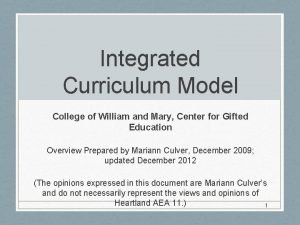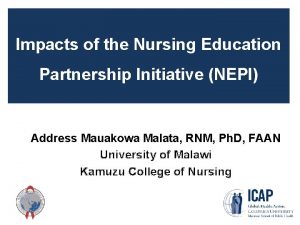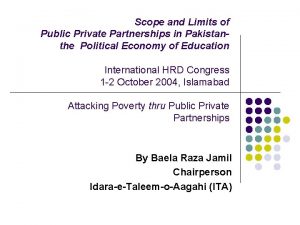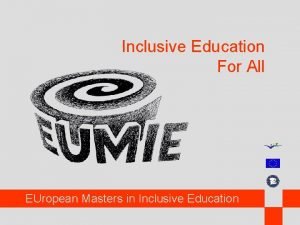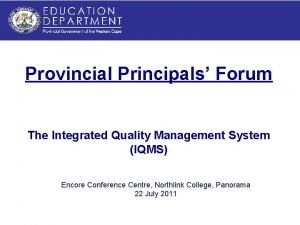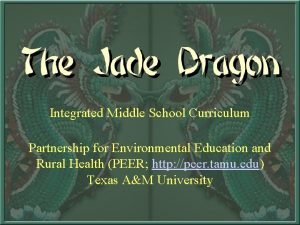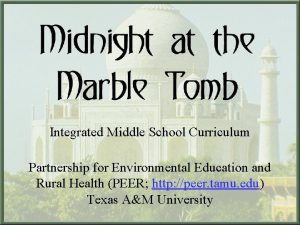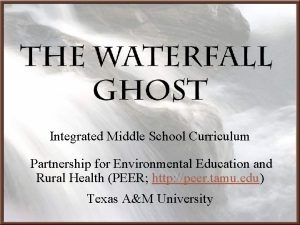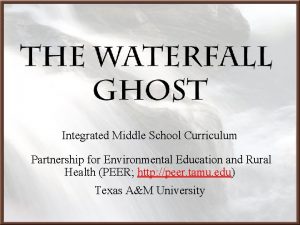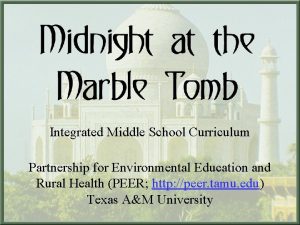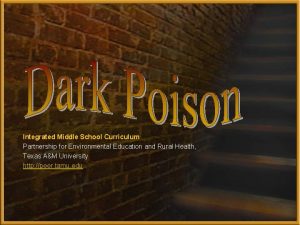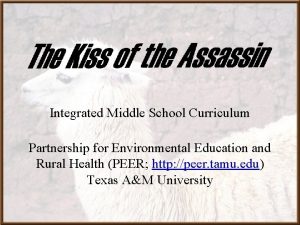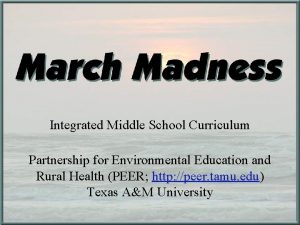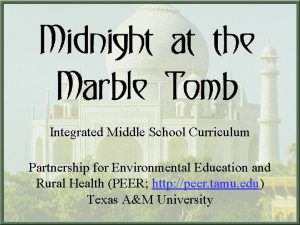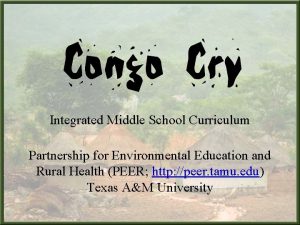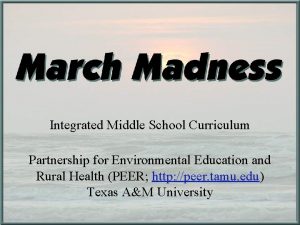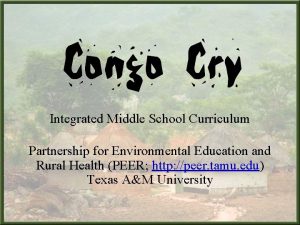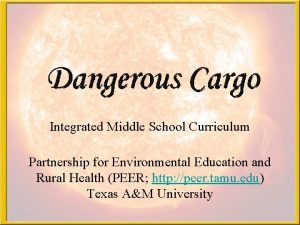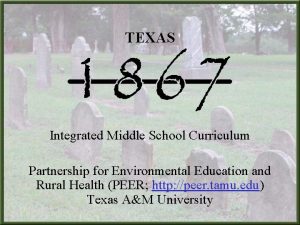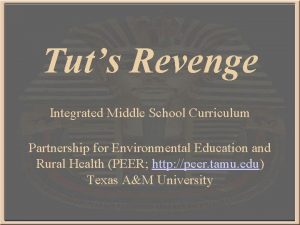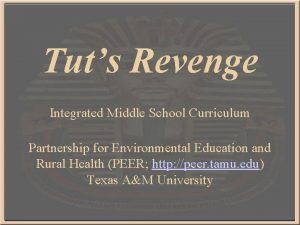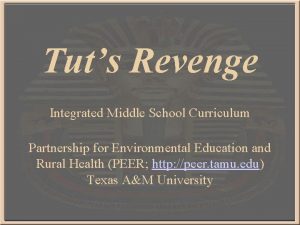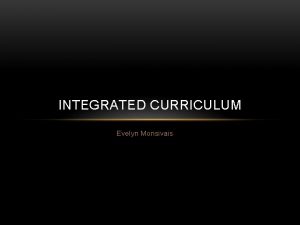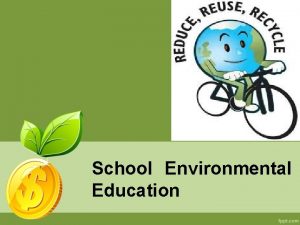Integrated Middle School Curriculum Partnership for Environmental Education










































































- Slides: 74

Integrated Middle School Curriculum Partnership for Environmental Education and Rural Health (PEER; http: //peer. tamu. edu) Texas A&M University

Primary Authors: Jon Hunter Bill Klemm Deborah Kochevar Jim Kracht Based on a story by Marguerite Swilling Production of the Partnership for Environmental Education and Rural Health funded by NIEHS, Larry Johnson, PI

Mr. or Ms. Smith’s class Your Middle School

Do you recall? • Read “Congo Cry” carefully. • Test your memory and understanding of important details by completing the Investigator’s Challenge Quiz. CO-1. 0

Where is Africa? The global address or absolute location of the center of Africa is 7 degrees North Latitude and 21 degrees East Longitude 7° N, 21° E • Is Africa in the Northern or Southern Hemisphere? • Is Africa in the Eastern or Western Hemisphere? CO-2. 0

N W E S Point and click on the center of Africa. (7° N, 21° E) CO-3. 0

N W E S Were you correct? Look for the highlight around Africa. What is the latitude for the most northern part of Africa? _______ ° N or S? What is the latitude for the most southern part of Africa? _______ ° N or S? What is the longitude for the most western part of Africa? _______ ° W or E? What is the longitude for the most eastern part of Africa? _______ ° W or E? CO-4. 0

Where is Kinshasa, Democratic Republic of the Congo (DRC)? The global address or absolute location of Kinshasa is 4. 4° S and 15. 4° E CO-5. 0

Point and click on Kinshasa, DRC. (4. 4° S, 15. 4° E) CO-6. 0

Were you correct? Look for the highlight around Kinshasa, DRC on the map. • What is the latitude for Kinshasa? _____° North or South? • What is the longitude for Kinshasa? _____° West or East? • The absolute location for Kinshasa, DRC is ______ ? CO-7. 0

N W E S The absolute location for Kinshasa, DRC is 4° N, 15° E. The absolute location of Houston, Texas is 30° N, 95° W. • Which city is further North? • Which city is closer to the Equator? • Which city is located in the Eastern Hemisphere? CO-8. 0 • Which city is located in the Western Hemisphere?

Look on the map above to find what cities match the addresses given below. CO-9. 0 1. What city is located at 0. 5° N, 25° E? ____________ 2. What city is located at 13° S, 27° E? _____________ 3. What city is located at 6. 5° S, 22° E? _____________ 4. What city is located at 3° S, 28° E? _____________

Were you correct? • Kisangani is located at 0. 5° N, 25° E • Lubumbashi is located at 13° S, 27° E • Kananga is located at 6. 5° S, 22° E CO-10. 0 • Bakavu is located at 3° S, 28° E

Just Checking • The global address of a place using latitude and longitude is known as _______. • Global addresses north of the equator are referred to as North _______. • Global addresses west of the Prime Meridian are referred to as West _______. • Both latitude and longitude are measured in _______. CO-11. 0

Test your understanding of latitude and longitude by taking the Absolute Location Challenge Quiz. CO-12. 0

Relative Location Where is the Democratic Republic of the Congo in relation to other places? CO-13. 0

N W E S The Democratic Republic of the Congo is highlighted in yellow on the map above. • On what continent is the Democratic Republic of the Congo located? • What continent is north of the Democratic Republic of the Congo? • What continent is west of the Democratic Republic of the Congo? CO-14. 0

N W E S If you were to travel to the Democratic Republic of the Congo from your home, in which direction would you travel? CO-15. 0

The Democratic Republic of the Congo is shaded on the map below. • What ocean is to the west of the Democratic Republic of the Congo? • What countries are to the east of the Democratic Republic of the Congo? • Name a lake located to the east of the Democratic Republic of the Congo. CO-16. 0

Bumba is highlighted on the map. • What city is the capital of the Democratic Republic of the Congo? • This city is located in what direction from Bumba? • The city of Isiro is located in what direction from Bumba? • If you were to travel directly north of Bumba, what country would you reach? CO-17. 0

Just Checking • You are talking with a friend. She asks, “Where is the Democratic Republic of the Congo? ” How would you respond? • If you were to travel from Texas to the Democratic Republic of the Congo, in which direction would you travel? • If you were to travel from the Democratic Republic of the Congo to Paris, France, in which direction would you travel? • Which of the following is closest to the Democratic Republic of the Congo? Germany / the USA / India CO-18. 0

Take a tour of the Democratic Republic of the Congo (DRC)! CO-19. 0

Quarantine! Two monkeys in the breeder colony were under quarantine before being shipped to Dr. Kathy Allen in Virginia. What does “quarantine” mean? Why do you suppose Dr. Allen wanted them quarantined? CO-20. 0

Investigate the Mystery • How many different instances of sickness are there in the story? • What about the environment could relate to the sicknesses? • What other clues are provided? • What hypothesis could you generate? How would you test it? See the Scientific Method Appendix for help. CO-21. 0

Who Has a Sickness? • • Who got sick, and who did not? What are the signs (symptoms) of sickness? Do all affected people show the same signs? What were these people exposed to that might have caused sickness? See the Infectious Diseases appendix to learn more. CO-22. 0

Observe the Signs Name at least 5 different sicknesses in the story. Are all these sicknesses likely to be caused by the same thing? Why or why not? CO-23. 0

What is your hypothesis about the cause of these illnesses? • • • Who was sick? Are the signs and symptoms the same? Where did the sick people live? What was the environment like? What environmental hazards can you identify? • Do the lifestyles of any of the people create a potential hazard? CO-24. 0 See the Scientific Method appendix to learn more.

Environment • Describe the climate in this part of Africa. • Is there any relationship between the sickness occurring in monkeys and that in humans? • What is the significance of the netting on the windows of the building in Yambuku? • Click here for more information on climate. CO-25. 0

Investigating Air Was there anything in the air that could have been causing these multiple instances of sickness? Why or why not? CO-26. 0

Investigating Food Was there any food exposure that might have caused one or more of these instances of sickness? Why or why not? CO-27. 0

Investigating Water Could any of these instances of sickness have been due to exposure to contaminated water? (Hint: One instance was clearly related to a river. ) Why or why not? CO-28. 0

Investigating Skin Contact At least four instances of sickness seem to have been associated with some kind of exposure by way of the skin or mucous membranes. What are they? Why are these likely to be due to infection rather than an environmental toxin? CO-29. 0

Possible Multiple Routes of Exposure • Could any of the instances of sickness involve possible multiple routes of exposure? • Which ones? Which routes? CO-30. 0

Hypothesis: Which one of several possibilities is the cause of sickness? CO-31. 0 • What does your mother do when you feel sick and have a sore throat? • Physicians use the symptoms shown by a person, along with the circumstances associated with his or her sickness, to identify possible causes of disease. • Then they pick the most likely cause (called making a “differential diagnosis”). • Why do they do this if they cannot really know at that time what the problem is?

What do swollen glands Indicate? The grandmother with flu-like symptoms had swollen glands. • What kinds of glands usually swell during infections? • Why do they swell? CO-32. 0 • What is the connection between swelling and antibodies?

Could some kind of infection cause the illnesses? What kinds of guidelines would you use to distinguish infections from environmental toxins? CO-33. 0

If you hypothesize that infections are involved, does it make sense that … • the specific microorganism can be found in all cases of diseased animals but not healthy ones? • the specific microorganism can be isolated from the diseased host and grown in culture media? • injecting this freshly isolated microorganism into a healthy laboratory animal should cause the same disease seen in the original animal? • the microorganism should be re-isolated in pure culture from the experimental infection? For more help, see the Infectious Disease appendix. CO-34. 0

Body Fluid Contact Four conditions are mentioned in the story in which the exchange of contaminated body fluids could have occurred. What are those conditions? CO-35. 0

Blood Screening The grandmother apparently got her infection from a blood transfusion. In modern blood banks, there antibody tests for blood. How could one test blood for safety without antibody testing? (Name three possibilities. ) For more on antibodies, click here. CO-36. 0

How Infections Are Spread • Microbes live in body fluids. • Contacting a body fluid of an infected person may spread an infection. • Typical microbe-spreading fluids: blood, saliva, urine, feces (esp. in diarrhea), semen, lung mucus. Go to the Infectious Disease Appendix CO-37. 0

Doctors tried treatment with antibiotics, but they did not work. Why is this? 1. Antibiotics only interfere with the multiplication of bacteria – not parasites or viruses. 2. Antibiotics stop the bacterial cell division, but replication in viruses different mechanisms. 3. The organisms might have been bacterial, but they evolved resistance to the antibiotic being used. What if no antibiotics are effective? CO-38. 0

Cycles of Life in Bacteria attach to target cells, penetrate, divide, and mature, often releasing toxins into the host, and may survive outside of the host in a protected form (spores). CO-39. 0

Cycles of Life in Viruses attach to target cells, inject viral DNA and RNA, force host genes to make new viruses or reproduce each time the host cell divides. New viruses are released to infect other cells. For more on DNA and RNA, click here. CO-40. 0

Cycles of Life in Parasites mature and divide in human hosts, shed from humans to another species or a protected environment, convert to an infective form, and are picked up by another human host. CO-41. 0

So what is the main difference in life cycles between bacteria, viruses, and parasites? CO-42. 0

Reviewing the Hypothesis in Light of the Evidence • Review your original hypothesis. • Does the evidence support it? • What could have been done to prevent the health problems in the story? CO-43. 0

Looking at the Math: Relative Ages If Travis is 14 years old and Aunt Kathy is 2 years older than twice his age, how old is Aunt Kathy? Dr. Tony Allen’s little sister is Kathy. If he is 23 years younger than twice Kathy’s age, how old is Dr. Tony Allen? CO-44. 0

Summer Job • Aunt Kathy hired Travis and Summer to • CO-45. 0 clean the monkey cages while she was in Africa. It takes them 30 minutes each day to finish their work. Aunt Kathy is paying each of them at an hourly rate of $6. 00. How much money will Travis and Summer make together this summer if Aunt Kathy is in Africa for 90 days? Get help with unit conversions.

Summer Job • If Dr. Allen offered Summer and Travis a 15% raise from their 6 dollar per hour pay to clean horse stalls, what would be their total combined pay if they spent three hours cleaning stalls? CO-46. 0 Find out more about percentages.

Box of Medicine • The box that Aunt Kathy had left behind measured 40 cm long by 16 cm wide by 16 cm high. The kids later found the box only contained needles that were packed in tubes with a diameter of 0. 8 cm and a length of 5 cm. Assuming the tubes are perfect cylinders, and there is perfect packing and no wasted space in the box, how many needles did Aunt Kathy’s box contain? CO-47. 0 Find out more about diameters.

Look Both Ways Before Crossing! • When the kids arrived in Kinshasa, the Doctors Without Borders office was just across the street. If it took Summer exactly 7 full turns of her 30. 5 cm radius wheelchair wheel to reach the office of Doctors Without Borders, how far were the kids from the office when they arrived in Kinshasa? • Express your answer in meters and then convert to feet. Find out more about circumference. CO-48. 0

Can you hear me now? • Aunt Kathy lost radio contact 2 days before arriving at Yambuku. If the radio battery was 2/3 charged when Kathy left for Yambuku and the battery has a 10 hour talk time when fully charged, how long did Aunt Kathy spend on it before losing contact? • What percent of talk time did Aunt Kathy have remaining before leaving for Yambuku? Learn more about converting fractions to percentages. CO-49. 0

The missing link? • Aunt Kathy was asked to help investigate the dying chimps since the chimp’s genetic closeness to humans makes it easier for disease (e. g. Ebola Virus) to cross our species barrier. The genome of a chimp is 98. 4% identical to that of a human. If humans have 30, 000 genes, how many of these are shared with chimps. CO-50. 0 Learn more about converting percentages to decimals.

Our Uniqueness • Humans are 99. 9 percent alike in their genetic makeup. The different genes make us unique and account for our different appearances. Assuming that humans have 30, 000 genes, how many genes account for our uniqueness? CO-51. 0 Learn more about converting percentages to decimals.

HIV Incidence • 26 million out of a total 36. 1 million HIVinfected people live in Africa. – What percentage of the world’s HIV-cases are located in Africa? • 850, 000 HIV-infected people live in the United States. – What percentage of the world’s HIV-cases are located in the U. S. ? CO-52. 0 Learn more about working with percentages.

Average Age at Time of Death Botswana CO-53. 0 Zambia Zimbabwe

Life Expectancy • According to the histogram on the previous page, what is happening to the average life expectancy in these African nations? • in By how many years have the life expectancies each of the countries fallen? • Which country had the greatest decrease in life expectancy? • Why do you think life expectancy has declined? CO-54. 0

Life Expectancy • If the decline of life expectancy continues at the same rate until 2010, predict what the average of death will be at that time. • Is it likely that the life expectancy decline will continue at the same rate? Why or why not? CO-55. 0

Blood Transfusion • During the past three years in South Africa, 1. 5 million blood donations were screened for HIV. All the blood samples were used for transfusions, but four were later found to contain the HIV virus. • What are the chances of being infected with HIV through a blood transfusion from this donated blood? • Suppose you have a 50 -50 chance of living if you refuse a transfusion. Which is more likely: A) Contracting HIV by receiving a transfusion. B) Dying by not receiving a transfusion. Learn more about probabilities. CO-56. 0

Medical Supplies The syringes used at Medecins Sans Frontieres were 8 cm in length and had a radius of 0. 7 cm. Approximately how many cubic centimeters (cc) of liquid medicine can a syringe with those dimensions hold? Learn more about length and volume. CO-57. 0

Traveling Across the Globe The shortest distance between Houston, TX and Kinshasa, DRC is 12, 223 kilometers (7, 334 miles). Given that the total circumference of the Earth is 40, 091 km. (24, 902 miles), what percent of the total circumference of the Earth did K. T. , Travis, and Summer traverse? Find out more about circumferences or percentages. CO-58. 0

Unlocking Language By understanding the construction of language and correct usage, you can improve your writing and speech. Review the Unlocking Language activities for “Congo Cry” to sharpen your language skills. CO-59. 0

Sounds of the Jungle Re-read the passage to the right. Identify one or more examples of each of the following: – Simile – Adjective – Personification CO-60. 0 Insect sounds washed through the moist air like waves. The crescendo filled her ears until she felt her own body humming, then fell back to a soft drone. The jungle is snoring, thought the young researcher.

What do you hear? • Divide into groups of 4 students. • Each student draws a different “listening” location from a pool of choices. • Don’t share your location with anyone! CO-61. 0

Describe What You Hear • Take pencil and paper and proceed to your “listening location. ” • Close your eyes and listen quietly for 3 -5 minutes. • Write down 5 -10 words that describe what you heard. • Use adjectives and at least two literary devices (e. g. , simile, metaphor, personification) to make your descriptions come alive! CO-62. 0

Make the Sounds Come Alive! • Write a short essay that conveys to your reader the environment of sound you experienced. • Read and critique all the essays written by your group. • For each essay, guess the location being described. CO-63. 0

Knowledge is Power • Several patients in Congo Cry are ill and may be infected with Human Immunodeficiency Virus (HIV), which causes Acquired Immune Deficiency Syndrome (AIDS). • Understanding how HIV is transmitted from one person to the next is very important if the goal is to prevent the spread of the disease. • If more people understand how HIV is transmitted, fewer may become infected. CO-64. 0

Knowledge is Power • Compose a one page letter that convinces the local government in Kinshasa to educate the townspeople about HIV. • Inform yourself about AIDS before writing the letter. Click here for more information on the AIDS virus. Also, use the internet, magazines or books as resources. • Remember to include information that supports your position that knowledge of how the disease is spread will help people avoid infection. CO-65. 0

Powers of Persuasion • Inform yourself about AIDS before writing the letter. Use the internet, magazines or books as resources. • Review the basics of persuasive writing as you build your case for public health education. CO-66. 0

Vocabulary Challenge • What do you see in this picture? Can you find the hidden animals in the branches of the trees? • Use clues to help you learn new vocabulary in the context (the branches) of a sentence. • Take the Vocabulary Challenge quiz to test your skill at finding word meanings. CO-67. 0

You Are the Author! • Read the modified passage on the right. • Now imagine that YOU are lying in the jungle and that something unexpected occurs. • Write a one page creative narrative that describes your jungle adventure! CO-68. 0 Here, deep in the Congo jungle, you hear a soft rustling in the canopy and the occasional eerie cry of an infant chimpanzee as it nests somewhere high above you. Then suddenly a loud, crashing noise can be heard approaching. You jump up to see…

Reviewing the Adventure • • What was the story all about? What did we learn about Africa? What were the health problems? What was it about the environment that was causing the health problems? How did we figure that out? • What could prevent the health problems? CO-69. 0

Teachers, please click on this link to complete a short survey concerning this module: http: //peer. tamu. edu/forms/Curricula_Survey. shtml. This product is available through the cooperation of the following: National Institute of Environmental Health Sciences Partnership for Environmental Education and Rural Health College of Education, Texas A&M University CO-70. 0 Department of Agricultural Education, Texas A&M University The Center for Environmental and Rural Health College of Veterinary Medicine, Texas A&M University

List of Slide Numbers Corresponding to the Different Subject Areas CO-71. 0 Science Slides 24 -46 Social Studies Slides 5 -23 CO 21. 0 -43. 0 CO 2. 0 -20. 0 English Slides 4, 62 -71 Math Slides 47 -61 CO 1. 0, 59. 0 -68. 0 CO 44. 0 -58. 0
 Wireless health
Wireless health Integrated curriculum model
Integrated curriculum model Integrated vs differentiated curriculum
Integrated vs differentiated curriculum Nursing education partnership initiative
Nursing education partnership initiative Scope of public-private partnership in education
Scope of public-private partnership in education Inclusive education and community partnership
Inclusive education and community partnership Miguel lopez melero
Miguel lopez melero Face mapping dermalogica
Face mapping dermalogica Heathfield junior school partnership
Heathfield junior school partnership Integrated holistic education system
Integrated holistic education system Integrated educational information management system
Integrated educational information management system Summary sheet of iqms scores
Summary sheet of iqms scores Iso 22301 utbildning
Iso 22301 utbildning Novell typiska drag
Novell typiska drag Nationell inriktning för artificiell intelligens
Nationell inriktning för artificiell intelligens Vad står k.r.å.k.a.n för
Vad står k.r.å.k.a.n för Varför kallas perioden 1918-1939 för mellankrigstiden
Varför kallas perioden 1918-1939 för mellankrigstiden En lathund för arbete med kontinuitetshantering
En lathund för arbete med kontinuitetshantering Kassaregister ideell förening
Kassaregister ideell förening Vilotidsbok
Vilotidsbok A gastrica
A gastrica Förklara densitet för barn
Förklara densitet för barn Datorkunskap för nybörjare
Datorkunskap för nybörjare Boverket ka
Boverket ka Hur skriver man en debattartikel
Hur skriver man en debattartikel Autokratiskt ledarskap
Autokratiskt ledarskap Nyckelkompetenser för livslångt lärande
Nyckelkompetenser för livslångt lärande Påbyggnader för flakfordon
Påbyggnader för flakfordon Lufttryck formel
Lufttryck formel Publik sektor
Publik sektor Jag har gått inunder stjärnor text
Jag har gått inunder stjärnor text Presentera för publik crossboss
Presentera för publik crossboss Jiddisch
Jiddisch Kanaans land
Kanaans land Klassificeringsstruktur för kommunala verksamheter
Klassificeringsstruktur för kommunala verksamheter Fimbrietratt
Fimbrietratt Bästa kameran för astrofoto
Bästa kameran för astrofoto Cks
Cks Programskede byggprocessen
Programskede byggprocessen Bra mat för unga idrottare
Bra mat för unga idrottare Verktyg för automatisering av utbetalningar
Verktyg för automatisering av utbetalningar Rutin för avvikelsehantering
Rutin för avvikelsehantering Smärtskolan kunskap för livet
Smärtskolan kunskap för livet Ministerstyre för och nackdelar
Ministerstyre för och nackdelar Tack för att ni har lyssnat
Tack för att ni har lyssnat Hur ser ett referat ut
Hur ser ett referat ut Redogör för vad psykologi är
Redogör för vad psykologi är Borstål, egenskaper
Borstål, egenskaper Tack för att ni har lyssnat
Tack för att ni har lyssnat Borra hål för knoppar
Borra hål för knoppar Vilken grundregel finns det för tronföljden i sverige?
Vilken grundregel finns det för tronföljden i sverige? Hur räknar man standardavvikelse
Hur räknar man standardavvikelse Tack för att ni har lyssnat
Tack för att ni har lyssnat Rita perspektiv
Rita perspektiv Informationskartläggning
Informationskartläggning Tobinskatten för och nackdelar
Tobinskatten för och nackdelar Toppslätskivling dos
Toppslätskivling dos Modell för handledningsprocess
Modell för handledningsprocess Egg för emanuel
Egg för emanuel Elektronik för barn
Elektronik för barn Klädsel i rom
Klädsel i rom Strategi för svensk viltförvaltning
Strategi för svensk viltförvaltning Var 1721 för stormaktssverige
Var 1721 för stormaktssverige Ellika andolf
Ellika andolf Ro i rom pax
Ro i rom pax Tack för att ni lyssnade
Tack för att ni lyssnade Samlade siffror för tryck
Samlade siffror för tryck Bra rim texter
Bra rim texter Inköpsprocessen steg för steg
Inköpsprocessen steg för steg Rbk fuktmätning
Rbk fuktmätning Etik och ledarskap etisk kod för chefer
Etik och ledarskap etisk kod för chefer Vad är hsil
Vad är hsil Myndigheten för delaktighet
Myndigheten för delaktighet Frgar
Frgar Sju principer för tillitsbaserad styrning
Sju principer för tillitsbaserad styrning

